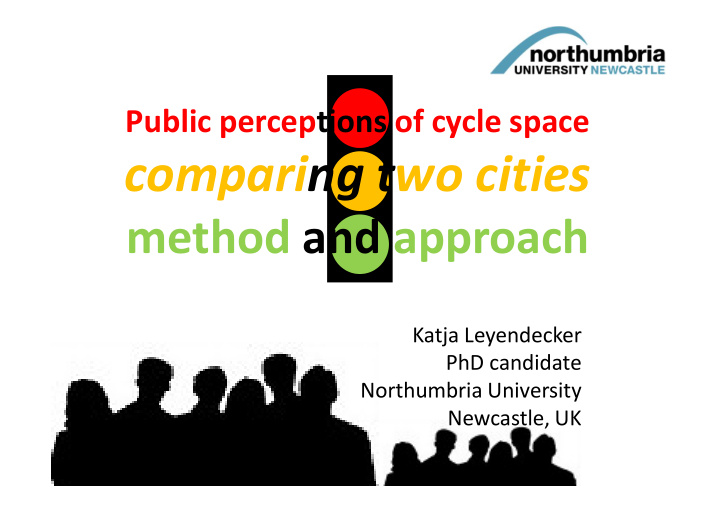



Public perceptions of cycle space comparing two cities method and approach Katja Leyendecker PhD candidate Northumbria University Newcastle, UK
Contents Global context UK context Socialisation Sensitive setting Recommended remedies X my research 2 / 18
From the academic message boards Jan Garrard Fiona Spotswood et al (2015) If you want to know if Despite significant national an urban environment supports cycling, you and local efforts over the last can forget about all the decade to stimulate uptake of detailed ‘bikeability cycling in the UK, levels of indexes’— just measure the cycling (particularly utility proportion of cyclists cycling) remain at around 2% who are female of journeys Source Scientific American 2009 3 / 18
Global context Sources: graph : Garrard, J., et al. (2012). Women and cycling. City cycling. J. Pucher and R. Buehler, Massachusetts Institute of Technology (MIT). 4 / 18 red : UK Census 2011, blue : VEP Bremen 2025
UK context Source : Census 2011 5 / 18
Socialisation Women’s lives are gendered: • Main care-giver (still) • Escorting (school run), shopping, chores and errands • More trips • Trip-chaining • Shorter distances • Complex travel diaries • Safety / security (vs) comfort / convenience These trips in High-cycling countries are cycled Low-cycling countries done by car 6 / 18 Lehner-Lierz, U. (1997). The role of cycling for women. The greening of urban transport. R. Tolley, Wiley and Son.
Sensitive setting Context, context, context… global positioning Location country / city Location descriptive factors • Mode share and shift potentials • Policies and their enactment for social change • Powerwebs and –landscapes and social norms Location history/past context, trajectory 7 / 18
Recommended remedies Part A – contextualising the socio-ecological model 8 / 18
Recommended remedies Part A – contextualising the socio-ecological model 9 / 18
Recommended remedies Part B – acknowledging power, control and agency 10 / 18
Recommended remedies Part B – acknowledging power, control and agency 11 / 18
Recommended remedies Part C – conceptual model Source: Mitra, R. (2013) . "Independent mobility and mode choice for school transportation: a review and 12 / 18 framework for future research." Transport reviews 33 (1): 21-43.
My research Phase 1 Phase 2 Phase 3 13 / 18
My research Phase 1 Phase 2 Phase 3 14 / 18
My research Phase 1 Quantify Newcastle + Gateshead Bremen ___________________________________________________________________ Population 490,000 550,000 Density person/km 2,000 1,700 Source : Wikipedia 15 / 18
My research Phase 1 Quantify Source: Philippe Crist (2013) . Love Cycling Go Dutch Conference, Newcastle 16 / 18
Reading material 1. Aldred, R., et al. (2015) . "Does More Cycling Mean More Diversity in Cycling?" Transport reviews: 1- 17. 2. Aldred, R. (2015) . "Adults’ attitudes towards child cycling: a study of the impact of infrastructure." European Journal of Transport and Infrastructure Research 15(2): 92 - 115. 3. Eyer, A. and A. Ferreira (2015) . "Taking the tyke on a bike: mother's; and childless women's space- time geographies in Amsterdam compared." Environment and Planning A 47(3): 691-708. 4. Garrard, J., et al. (2012) . Women and cycling. City cycling. J. Pucher and R. Buehler, Massachusetts Institute of Technology (MIT). 5. Goodman, A. (2013) . "Walking, cycling and driving to work in the English and Welsh 2011 census: trends, socio-economic patterning and relevance to travel behaviour in general." PLoS ONE 8(8): e71790. 6. Jarvis, H. and S. Alvanides (2008) . "School choice from a household resource perspective: Preliminary findings from a north of England case study." Community, Work & Family 11(4): 385- 403. 7. Hillman, M., et al. (1990) . One false move: a study of children's independent mobility. London, PSI. 8. Mitra, R. (2013) . "Independent mobility and mode choice for school transportation: a review and framework for future research." Transport reviews 33(1): 21-43. 9. Shaw, B., et al. (2012) . Children’s independent mobility: a comparative study in England and Germany (1971-2010). London: Policy Studies Institute. 10. Spotswood, F., et al. (2015) . "Analysing cycling as a social practice: An empirical grounding for behaviour change." Transportation Research Part F: Traffic Psychology and Behaviour 29: 22-33. 17 / 18
Thanks for listening Email katja.leyendecker@northumbria.ac.uk Blog https://katsdekker.wordpress.com/ Twitter @katsdekker 18 / 18
Recommend
More recommend